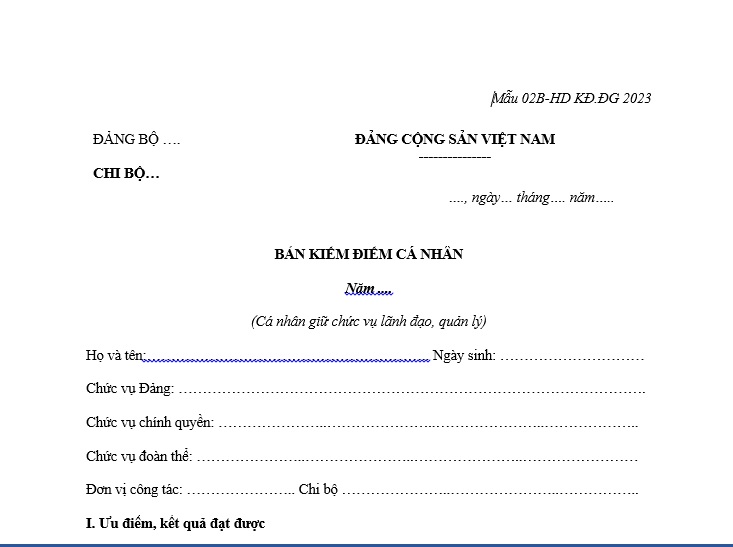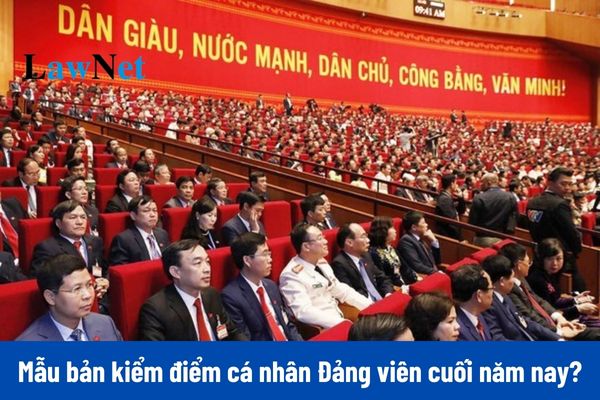What is the Form 02B for the self-assessment report of members of Communist Party of Vietnam at the end of 2024? How much is the membership fee for members of Communist Party of Vietnam in political organizations?
What is the Form 02B for the self-assessment report of members of Communist Party of Vietnam at the end of 2024?
Form 02B-HD KD.DG 2023 is the template for the self-assessment report of members of Communist Party of Vietnam at the end of 2024 for individuals holding leadership and management positions, issued along with Guideline 25-HD/BTCTW of 2023. To be specific:

Form 02B for the self-assessment report of members of Communist Party of Vietnam at the end of 2024 for individuals holding leadership and management positions...Download
See also:
>>> How to write an self-assessment report for CPV members at the end of 2024?
New:
>>> What are the classification levels for evaluating CPV members at the end of 2024?
>>> Which template should a CPV member use for end-of-year assessments in 2024?

What is the Form 02B for the self-assessment report of members of Communist Party of Vietnam at the end of 2024? (Image from the Internet)
How much is the membership fee for members of Communist Party of Vietnam in political organizations?
According to Section 1, Part B of the Regulation on membership fee policies issued in conjunction with Decision 342/QD-TW of 2010, it is stipulated regarding the subjects and the monthly membership fee rates. To be specific:
Subjects and monthly membership fee rates for CPV members
Monthly income of a CPV member for calculating the membership fee includes: salary, certain allowances; wages; living expenses; other income. CPV members with a regular income will pay a membership fee according to a percentage (%) of their monthly income (excluding personal income tax); CPV members with difficulty determining their income will be given specific monthly rates for each category.
1- CPV members in administrative agencies, political organizations, socio-political organizations, armed force units: pay a monthly membership fee equal to 1% of salary, allowances, wages, living expenses.
2- CPV members receiving social insurance pensions: pay a monthly membership fee equal to 0.5% of the social insurance pension amount.
3- CPV members working in businesses, public service providers, economic organizations: pay a monthly membership fee equal to 1% of salaries, wages, and other income from the unit's wage fund.
4- Other CPV members domestically (including CPV members in agriculture, rural areas, students…): pay a membership fee from VND 2,000 to VND 30,000 per month. For CPV members beyond working age, the membership fee is 50% of that for those within working age.
5- CPV members living, studying, working abroad
5.1- CPV members working at Vietnamese representative offices abroad; CPV members who are international students sponsored by foreign entities or funded by state budget will pay a membership fee equal to 1% of their monthly living expenses.
5.2- CPV members studying abroad on their own; CPV members working under labor export agreements; CPV members accompanying family, free business and living individuals, pay a monthly fee of 2 to 5 USD.
5.3- CPV members who own or co-own businesses, commercial zones, service shops, pay a minimum monthly fee of 10 USD.
6- Encouraging CPV members from all the above categories to voluntarily pay a higher membership fee than the regulated rate with the approval of the Party cell.
CPV members with particularly difficult circumstances can apply for waiver or reduction of the membership fee, with the cell considering and reporting to the grassroots Party committee for a decision.
Thus, CPV members in political organizations, socio-political organizations will pay a monthly membership fee equal to 1% of the salary, allowances, wages, and living expenses.
What is the method, procedure for evaluating, classifying CPV members?
According to Article 11 Regulation 124-QD/TW of 2023, the method and procedure for evaluating, classifying CPV members are as follows:
- Based on the evaluation criteria, quality classification standards specified for each group, individual, and opinions of relevant agencies participating in the evaluation, determine the level achieved for each criterion in 4 levels (Excellent, Good, Average, Poor), serving as a basis for the competent authority to give remarks, evaluate, and classify quality for each group, individual.
- The annual quality evaluation and classification for groups, individuals is conducted in 3 steps:
Step 1: Self-evaluation and classification by the group, individual.
Based on classification criteria, each organization, group, individual analyzes quality and classifies into 1 of 4 levels as stipulated in Article 12 Regulation 124-QD/TW of 2023.
Step 2: Appraisal and propose classification level.
Based on the self-evaluation results, classification of the group, individual, and the opinions of relevant participating agencies, the personnel organization advisories appraise and propose the quality classification level.
Step 3: Competent authority decides the quality classification.
For groups, individuals post-evaluation and classification results, if there are complaints, denouncements, signs of party discipline violations, state law, internal unity issues, higher-level Party committees will direct inspection, verification, appraisal, re-evaluation of the classification results.
- Evaluation and classification prioritize government activities, professional, union work first, Party organization later; lower-level group first, higher-level after; leadership, management groups first, individual members later.
+ After completing the evaluation, classification of localities, organizations, agencies, units, the evaluation and classification of the leader will be conducted.
+ Ensure consistent evaluation and classification for organizations, leadership, management groups from grassroots to provincial levels, Party committees, Party caucus, Party delegations, Party committees under the Central Committee.










- What are guidelines for salary arrangement of ranks of tax officials in Vietnam?
- What are 02 submission methods of Form 01/PLI on employment report for the last 6 months of 2024 in Vietnam? What is the union fee for members in people's armed forces in Vietnam?
- Who is a intermediate tax inspector in Vietnam? What are the duties?
- What is the VAT rate on endodontic treatment services in Vietnam?
- Is an information technology center subject to VAT in Vietnam?
- Are rice and corn harvesters subject to VAT in Vietnam?
- Are agricultural tractors exempt from VAT in Vietnam?
- What is the form of report on operation of tax agent in Vietnam in 2024? Shall a tax agent be suspended from business if it does not submit the operation report?
- VAT rate increased from 5% to 10% for film production services in Vietnam: What are significant amendments in the draft Value-Added Tax Law?
- From January 1, 2025, which entities are exempt from road user charges at toll plazas in Vietnam?

